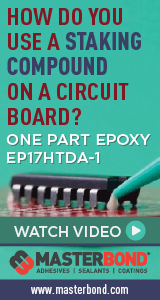|

|
|
| Ask the Experts | |||||||
|
|||||||
|
November 4, 2024 - Updated December 3, 2013 - Originally Posted Bottom Side Chip BondingWhen should we use adhesive to bond SMT components to the bottom side of a double sided PWA before going thru reflow soldering? Component size, weight, etc. D.M. |
|||||||
| Expert Panel Responses | |||||||
|
As a well known IPC member likes to say, "It depends." (D. Pauls - Rockwell Collins) Typically in a double sided reflow SMT adhesive isn't required. One side of the assembly is pasted, placed, and then reflowed. Then the second side is run through the same process of paste, place, then reflow. The reflowed solder for the components hanging down on the bottom of the board should be sufficient to hold the components in place. I haven't seen much usage of adhesive in double sided reflow. Having said that, there are exceptions to everything. If you have a relatively heavy component and you are having issues of the component falling off in reflow, then an adhesive may be appropriate. As usual, it falls to the designer/manufacturer to determine when an adhesive is appropriate.
Manager of Assembly Technology IPC Kris Roberson has experience as a machine operator, machine and engineering technician and process engineer for companies including Motorola, and US Robotics. Kris is certified as an Master Instructor in IPC-7711 / 7721, IPC A-610 and IPC J-STD 001.
This is a really good question. In fact, there is a bunch of incorrect information out there on this. There are a number of variables that affect "inverted adhesion" during a second reflow operation, but the prime variable is the ratio of the total peripheral length of all solder joints to the component mass. The second-most important variable is the solder alloy being used; SN63 has a much lower surface energy, so a lower retention force, than most Pb-free alloys. It's more than 30% lower than SAC305, for instance. The "retention force" due to the surface energy of the solder normally should be at very least 1.5 times the part mass, preferably 2 times the mass. All this assumes that the solder joints are distributed relatively evenly around the center of mass of the part; if not, a simple ratio calculation will fail to predict accurately. For most components this condition is at least approximately met. It can be challenging to do this calculation for a lot of parts, but normally you can do it by part class, and determine that "parts larger than X" should be affixed. I have done quite a bit of work in this area, and because this calculation is needed on a repeated basis, I have put together an Excel worksheet to do the calculation. If you would like a copy of this worksheet,please e-mail me directly, I would be glad to provide it.
Process Engineer Astronautics Fritz's career in electronics manufacturing has included diverse engineering roles including PWB fabrication, thick film print & fire, SMT and wave/selective solder process engineering, and electronics materials development and marketing. Fritz's educational background is in mechanical engineering with an emphasis on materials science. Design of Experiments (DoE) techniques have been an area of independent study. Fritz has published over a dozen papers at various industry conferences.
There should not be a normal situation where the components are glued to the bottom side of a PCBA if only seeing double sided reflow. The chip bonder epoxy is used for direct contact for wave solder processes. In unique situations with large components and thin PCBs the use of chipbonder can assist in reducing stress during second side reflow but the larger components should be on the second side not the first. A pallet can be used to reduce the thermal impact on the second side if need be.
President/Senior Technical Consultant Foresite Mr. Munson, President and Founder of Foresite, has extensive electronics industry experience applying Ion Chromatography analytical techniques to a wide spectrum of manufacturing applications.
Unfortunately this is another questions that bring the "it depends" answer. Usually the components placed on the first side of the board do not have to be bonded since the "surface tension" of the solder will hold them in place. Every rule has exceptions and those will have to be evaluated separately based upon component weight, number of leads and contact surface with the board. On a typical reflow equipment with bottom and top side heaters, you can set up profiles that have the bottom zone(s) setting(s) slightly cooler than the top and that will prevent components from falling during the second reflow. I'm referring here to the above liquidos temperature zones. This will eliminate the need for component bonding. I've tried it for years and it works very good.
Engineering and Operations Management Independent Consultant Georgian Simion is an independent consultant with 20+ years in electronics manufacturing engineering and operations.
Contact me at georgiansimion@yahoo.com. |
|||||||
| Submit A Comment | |||||||
|
Comments are reviewed prior to posting. You must include your full name to have your comments posted. We will not post your email address. |
|
Free Newsletter Subscription
Circuitnet is built for professionals who bear the responsibility of looking ahead, imagining the future, and preparing for it. Insert Your Email Address |
|

|






